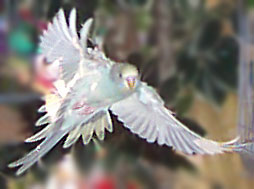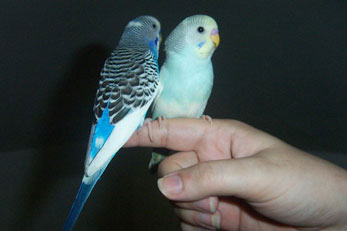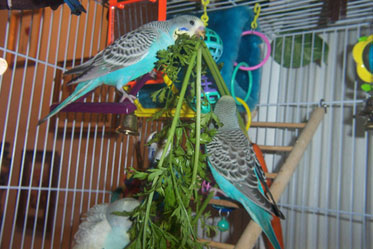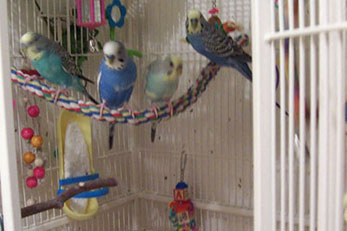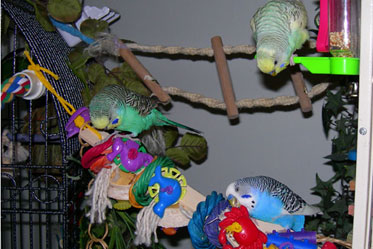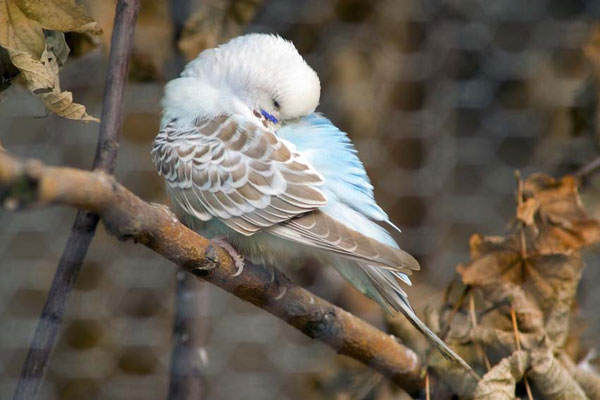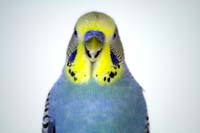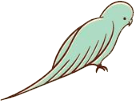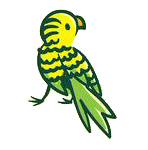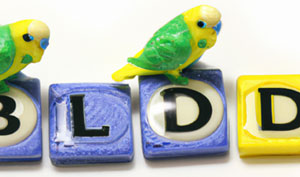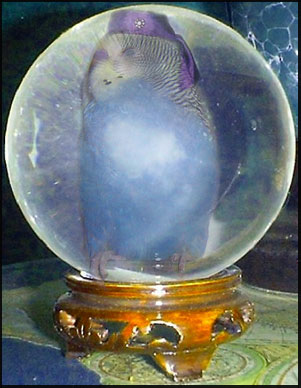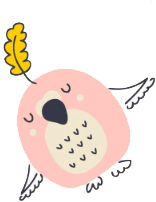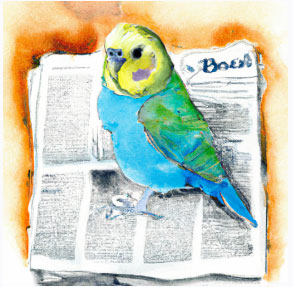About Budgies
On This Page:
- The Budgie
- Budgie Etymology
- Is My Budgie Female or Male?
- Budgie Appearance
- The Head of a Budgie
- Budgie Legs and Feet
- Fluffy White Budgie Butt and Cloaca
- Budgie Mutations
- Budgie Personality
- Budgie Vision
- Budgie Habitat
- Budgie Preening
- Budgie Sleeping
- Budgie Lifespan
- Cuttlebone
- Budgie Diet and Nutrition
The Budgie
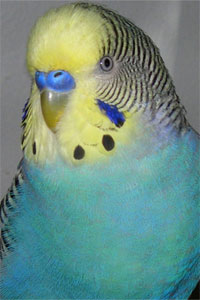
Have you ever noticed how budgies always seem to be chirping away? It's no wonder they're called "budgies" - short for "budgerigars" - because they're always prattling on about something! But where do these little feathery friends come from?
Believe it or not, budgies are native to Australia. They are found in the grasslands and scrublands of the outback, where they feed on seeds and grasses. Budgies are also known to visit watering holes to drink and bathe, and they often form large flocks to forage for food. It is said that the skies in the outback are often "black with budgies".
But how did Australian native birds become such popular birds around the world? It turns out, budgies were first introduced to Europe in the 1800s, where they quickly became popular as companion birds. They were later imported to the United States in the 1900s, where they gained even more popularity in everyday households.
Today, budgies are beloved for their playful and social personalities, as well as their ability to mimic human speech. It's no wonder these little dudes have become such beloved companions!
So, the next time you see one of those adorable little birds, you can impress your friends with your knowledge of their origins.
Budgie Etymology
Have you ever wondered where the word "budgie" came from? No, it's not just a cute name for parakeets. It turns out, "budgie" is actually short for "budgerigar," which is a mouthful (pun intended) of a word.
So, where did this strange word come from? Believe it or not, "budgerigar" is actually derived from the Wiradjuri language, which is spoken by the indigenous people of New South Wales, Australia. Terrible but true, the word "budgerigar" means "good to eat" in Wiradjuri, which is a little unsettling when you think about it. Thank goodness our little feathery friends are more commonly kept as companions rather than being served up on a plate!
But how did a word from an indigenous Australian language become the name for a popular bird? It turns out, "budgerigar" was adopted as the official scientific name for the species in 1891 by naturalist Gregory Mathews. Mathews named the bird after its original indigenous name, and it stuck.
Is My Budgie Female or Male?
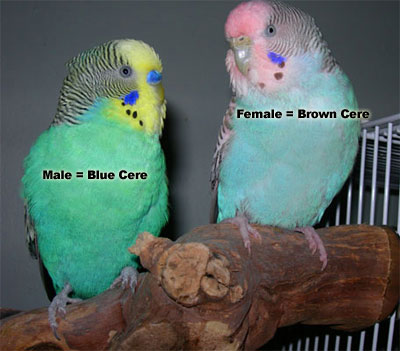
Adult female budgies have a brown or pink cere (the fleshy area above their beak) while adult male budgies typically have a bright blue cere. It's worth noting that these color differences may not be present in very young budgies, so it may be necessary to wait until they are fully mature to accurately determine their sex.
A female budgie that has just had a clutch may have their brown cere turn blue.
If a male budgie's cere turns brown, this could be an indication of testicular cancer.
Budgie Appearance
A budgie is a small, adorable type of parakeet that has become popular all over the world.
Budgies are small birds, typically only about 7.09 inches long from head to tail. They have a slender body and long, thin wings, which they use to fly and navigate through their natural habitat of the Australian outback.
It's budgie's coloring that really sets them apart. Budgies come in a wide variety of colors, ranging from bright greens in nature to blues to more muted shades of yellow and white in captivity. Some budgies, like Skye, can be pink (after demolishing a strawberry mineral block), or have a bright orange beard (after shredding a carrot stick).
The Head of a Budgie
The most striking feature of a budgie is their head. They have a small, round head with a pointed hooked beak that they use to crack open seeds and nuts. Budgies, unlike chickens, will always hull their seeds first and therefore do not need grit to break open seed shells in their stomach. They will even hull soft peas. Hilarious! They have bar stripes on their foreheads - these bar stripes are most prominent when they are very, very young and as they get older, the bar stripes recede. This is one of the ways you can approximate an age for a budgie. Above their beak, they have a fleshy area called a cere, which is typically blue in males and brown or pink in females. They also have two bright, beady eyes that twinkle with mischief and curiosity.
Budgie Legs and Feet
Budgies are adapted for life in the trees. In their natural habitat of the Australian outback, they use their strong legs and feet to climb up branches and hop from perch to perch. Their feet are quite flexible, with three toes facing forward and one toe facing backward. This allows them to grasp onto branches and perches with ease. Unlike some other grass parakeets like rosey bourke parakeets, they can climb their cage walls.
Budgies have long, thin legs, the tops of which appear to be wearing stylish little fluffy budgie pants - they are covered in small, fine feathers. These feathers help to keep their legs warm and protect them from the elements. Their legs are also quite strong, allowing them to support their body weight as they hop and climb around.
Fluffy White Budgie Butt and Cloaca
No matter the color of the budgie, their butt fluff is always white. These feathers serve an important purpose - they help to keep the budgie warm and insulated, especially in colder weather.
The cloaca is a common opening found in many birds (and other animals) that is used for the elimination of waste and the reproduction of offspring. In budgies, the cloaca is located just above the fluffy butt feathers. It's not exactly the most glamorous part of a budgie's anatomy, but it serves an important purpose. When budgies mate, the female will go low and flatten her back, with her neck craned backwards. The male will stand on top of her back and wrap a wing around her for balance. They will then rub their cloaca's together until he loses his grip and falls off. Sometimes, if the male budgie is young and inexperienced, they will just stand on the female's back, proudly gazing about, puffing out their chest, all "I'm King of The World!" until the female budgie gets frustrated and annoyed and kicks him off.
These may not be the most glamorous parts of a budgie's anatomy, but they are certainly important. And who knows - maybe one day we'll even have a fancy name for the fluffy butt, like we do for the cere.
Budgie Mutations
- Clearwing: A budgie with transparent or translucent wings and a normal-colored body, giving them a "see-through" appearance, caused by a mutation in the "Sry-related HMG-box 2" gene.
- Fallow: A budgie with a pale beige body and red eyes, caused by a mutation in the "brown" gene.
- Lutino: A bright yellow budgie with red eyes, caused by a mutation in the "eumelanin" gene.
- Opaline: A budgie with a white or yellow body and dark markings on the wings and tail, caused by a mutation in the "tyrosinase" gene.
- Pied: A budgie with a white body and patches of normal color on the wings and tail.
- Spangle: Spangle budgies have a pattern of black and white on their wings, giving them a "spangled" appearance. A budgie with a white face and head, and blue, green, or black markings on the rest of the body, caused by a mutation in the "insulin-like growth factor 1 receptor" gene.
- Whiteface: A budgie with a white face and head.
- Yellowface (yellow-faced): Yellowface budgies have a yellow head and face, with the rest of the body being a normal green color.
- Recessive pied: Recessive pied budgies have a more extensive piebald pattern than regular pied budgies.
- Dilute: Dilute budgies have a pale, washed-out version of their normal color.
- Dark-eyed clear: These budgies have normal coloring, transparent wings and dark eyes.
- Cobalt: Cobalt budgies are a deep, rich blue color.
- Cinnamon: Cinnamon budgies have a reddish-brown coloration.
- Normal green: This is the most common color for budgies, with green feathers on the body and yellow on the head.
- Olive: Olive budgies are a greenish-brown color.
- Skyblue: These budgies have a light blue coloration all over their bodies, with no yellow on the head.
- Grey: Grey budgies have a mostly grey, greyish-blue plumage, with some white and black mixed in.
- Mauve: These budgies have a pale purple or lavender coloration.
- Yellow-sided: Yellow-sided budgies have yellow on the sides of their bodies, with the rest of the plumage being a normal green color.
- Albino: Albino budgies are completely white with pink or red eyes.
- American cinnamon: American cinnamon budgies have a darker, more red-brown coloration than regular cinnamon budgies.
- Australian mist: A budgie with a blue-grey body and green wings.
- Crested: A budgie with a small crest of feathers on its head.
- Dominant pied: A budgie with a white body and patches of normal color on the wings and tail. Dominant pied budgies have a piebald pattern that is caused by a dominant gene.
- Emerald: A budgie with a bright green body and yellow head.
- Greygreen: These budgies have a greyish-green coloration.
- Violet: A pale purple budgie.
Budgie Personality
Budgies are highly social creatures. They are known to form strong bonds with their human caregivers, as well as with other birds in their flock. They are also known to be quite playful and energetic, often engaging in activities such as climbing, swinging, and playing with toys.
It's budgie's ability to mimic other animals speech and music. While not all budgies are great talkers, many are able to learn a few words and phrases with proper training and repetition. This can be a lot of fun for budgie companions, as it allows them to have conversations with their feathered friends.
Budgies have their own unique personality and quirks. Some budgies may be more timid and reserved, while others may be more outgoing and vocal. It's important to get to know your budgie and understand its individual personality in order to provide the best care and companionship.
Budgie Vision
Budgies have excellent vision. They are able to see a wide range of colors and have good visual acuity, meaning that they are able to see small details and objects clearly. This is especially useful for budgies in the wild, as it allows them to spot predators and locate food sources.
Like many birds, Budgies have tetrachromatic color vision, but all four classes of cone cells operating simultaneously requires the full spectrum provided by sunlight.
Budgie Habitat
These little birds are native to Australia and are known for their nomadic ways. You can find them in open habitats like scrubland, open woodland, and grassland, where they roam in small flocks (but can form massive flocks under the right conditions). It's all about the availability of food and water for these little guys - if there's a drought, they might even venture into more wooded areas or coastal areas to find what they need. As for their diet, budgies love to munch on seeds from spinifex and grass weeds, and sometimes they'll even nibble on ripening wheat if they can get their beaks on it.
Budgie Preening
Preening is an important activity for budgies and other birds. It helps to keep their feathers clean and in good condition, which is essential for flight and insulation. Preening also helps to remove parasites and debris from the feathers, and can even help to strengthen the bond between flock members.
But how do budgies preen? Well, they have a special tool for the job - a "preening gland" located just above the base of their tail, and it is about the size of a small pea. When preening, you may see them rub their head on this gland. This gland produces an oil that the budgie spreads over its feathers during preening. The oil helps to keep the feathers supple and waterproof, and it also has a unique scent that can be used to communicate with other birds.
Budgies also preen their flock members, including humans! If your budgie is feeling particularly affectionate, it may try to preen your hair or clothing. This is a sign of bonding and trust, and is a sure sign that your budgie considers you part of its flock.
Budgie Sleeping
Budgies, like most birds, sleep standing up. They often fluff up their feathers, trapping in warm air, and making themselves cozy. This allows them to be ready to take flight at a moment's notice if they sense danger. They also tend to tuck their head under a feathery shoulder and close their eyes, which helps to keep them warm and protected while they sleep.
Budgies, like most birds, tend to sleep in short bursts throughout the day and night. This is known as "polyphasic sleep," and it allows them to remain alert and ready to take flight if necessary. Humans, on the other hand, tend to sleep in longer periods of time and are more vulnerable to predators when they sleep.
Budgie Lifespan
Budgies have a relatively short lifespan compared to humans. In the wild, budgies typically live for around 5-8 years, although some individuals have been known to live for up to 10 years. This is due in part to the harsh conditions of the Australian outback, where budgies must contend with predators, disease, and limited resources.
In a domestic setting, budgies can live for up to 15 years or more with proper care and nutrition. This includes a varied diet, clean living quarters, and regular health check-ups.
Cuttlebone
Cuttlebones are the internal skeletons of cuttlefish, a type of marine mollusk. They are rich in calcium and other minerals, making them an important dietary supplement for birds.
Budgies, like most birds, need to constantly trim and file their beaks in order to keep them in good condition. A cuttlebone provides a natural and safe way for them to do this. It also helps to keep their beaks strong and healthy, which is essential for eating and other activities.
Budgie Diet and Nutrition
Budgie's should not be fed a seed-only diet. Budgies need a variety of fresh fruits and vegetables. These can be offered in small amounts in addition to seeds and pellets and can help to provide important nutrients and antioxidants. Some good options include dark leafy greens, such as kale and spinach, broccoli, carrot tops, dandelion greens, as well as colorful fruits and vegetables like apples, bananas, carrots, and peppers.
It's also important to provide your budgie with a source of calcium, such as a cuttlebone or mineral block. This will help to keep its bones strong and healthy.
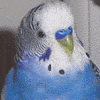 BudgieCare
BudgieCare